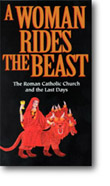Patrick j miron
TRENT An In depth Study part 3
[Need to make a correction to last weeks mail out. Part 2: I … claimed the church of England started about 200 years before Luther…NOPE; it started in the same general time frame as the Protestant revolt L So Sorry!] [Thanks J.B.]
The Inquisition
The Inquisition was a Roman Catholic tribunal for discovery and punishment of heresy, which was marked by the severity of questioning and punishment and lack of rights afforded to the accused.
While many people associate the Inquisition with Spain and Portugal, it was actually instituted by Pope Innocent III (1198-1216) in Rome. A later pope, Pope Gregory IX established the Inquisition, in 1233, to combat the heresy of the Abilgenses, a religious sect in France. By 1255, the Inquisition was in full gear throughout Central and Western Europe; although it was never instituted in England or Scandinavia.
Initially a tribunal would open at a location and an edict of grace would be published calling upon those who are conscious of heresy to confess; after a period of grace, the tribunal officers could make accusations. Those accused of heresy were sentenced at an auto de fe, Act of Faith. Clergyman would sit at the proceedings and would deliver the punishments. Punishments included confinement to dungeons, physical abuse and torture. Those who reconciled with the church were still punished and many had their property confiscated, as well as were banished from public life. Those who never confessed were burned at the stake without strangulation; those who did confess were strangled first. During the 16th and 17th centuries, attendance at auto de fe reached as high as the attendance at bullfights.
In the beginning, the Inquisition dealt only with Christian heretics and did not interfere with the affairs of Jews. However, disputes about Maimonides’ books (which addressed the synthesis of Judaism and other cultures) provided a pretext for harassing Jews and, in 1242, the Inquisition condemned the Talmud and burned thousands of volumes. In 1288, the first mass burning of Jews on the stake took place in France.
In 1481 the Inquisition started in Spain and ultimately surpassed the medieval Inquisition, in both scope and intensity. Conversos (Secret Jews) and New Christians were targeted because of their close relations to the Jewish community, many of whom were Jews in all but their name. Fear of Jewish influence led Queen Isabella and King Ferdinand to write a petition to the Pope asking permission to start an Inquisition in Spain. In 1483 Tomas de Torquemada became the inquisitor-general for most of Spain, he set tribunals in many cities. Also heading the Inquisition in Spain were two Dominican monks, Miguel de Morillo and Juan de San Martin.
The Council had been called to examine doctrine and reform. Charles V had wanted abuses looked at first in an attempt to please the Protestants and hopefully tempt them back to the church. Once they were back they could look at doctrine. Paul III did not want this as reforms could financially damage him and concessions could diminish his authority. The result was that two separate sections dealt with reform and doctrine simultaneously.
ed note-- continue with patrick j miron
Conflicting Interests
In 1537, Paul III called for a council, but political squabbles postponed its opening for eight years. The council finally began, in the northern Italian city of Trent, in 1545. The council held a number of meetings, with the three main sessions occurring in 1545–7, 1551–2, and 1562–3. The drawn-out sessions, and long delays between them, meant that representatives changed over the course of the council. And attendance was small; the opening session attracted only 34 leaders, and the largest meeting of the third session had only 255.
The council brought together a variety of competing agendas. Some churchmen, particularly members of the papal curia, resisted any reforms that would hinder their lifestyles. Bishops from Spain and France wanted a stronger, independent role. The Jesuits, on the other hand, stood firmly for papal supremacy. Some council delegates, like Emperor Charles V (who faced a Protestant challenge in his realm, the vast Holy Roman Empire), wanted Protestants and Catholics to reach a compromise. (Under his pressure, the council allowed Protestants to attend the second session, and informal talks were held. But when Protestant demands were not put on the agenda, the Protestants left, in 1552.) In a few instances, the delegates came to blows.
Resolutions
Reform was high on the agenda. On the issue that had sparked the Reformation—the selling of indulgences—the council abolished indulgence sellers and halted some of the worst abuses. In addition, the council passed numerous measures to halt clerical corruption.
Acknowledging that Luther’s revolt had been prompted by the “ambition, avarice, and cupidity” of clergy, it called for leaders to avoid “even the smallest faults.” Many abuses were condemned, such as holding several cathedral churches, offering favors to relatives, and having mistresses. [Never forget dear friends that we MUST ALWAYS separate “the Church” {Mother Church ‘ the Bride of Christ} from Her members.
INTERESTING COMMENTARY DELUSION FOLLOWING OF PATRICK J MIRON
#8756
" WE CAN SIN; the CHURCH CANNOT! “One Holy” -Catholic Church is the reality and the foundation of our faith-beliefs."
The council dealt extensively not only with morality, but also with doctrine. It reaffirmed the traditional medieval understanding—and rejected contemporary Protestant teaching—on nearly every subject.
The council held that there are seven sacraments, not two as the Protestants claimed, and that these are necessary for salvation. All the Protestant interpretations of Communion were condemned, and transubstantiation (the belief that the bread and wine become in substance the body and blood of Christ) was re-affirmed. Protestants were worshiping in their own languages, but the council upheld the Latin Mass, and it defined more precisely the sacrificial understanding of the Mass.
On the critical issue of justification, the council could not support the Reformation understanding of salvation by faith alone. It affirmed that no person can know for certain he or she is justified, and that good works do contribute to a right standing with God.
On the issues of Scripture and authority, the Catholic church moved further from Protestants. Reformers such as Luther had been translating the Bible into the common language of the people. The council held instead that the only official version of the Bible was the Latin Vulgate, and that no private interpretations of Scripture could depart from the church’s teachings. It also rejected the Protestant view of “Scripture alone” and declared that along with the Scriptures, tradition as preserved by the church was a source of authority.
Results
The Council of Trent helped to bring much-needed reform to the Catholic church. It also refined the church’s structure and marshaled its forces for the years ahead.
On matters of doctrine, however, the council made the gulf between Catholics and Protestants deep and lasting. Any remaining hopes of reunion were dashed.
The Council of Trent defined what the church would be for four centuries. Not until Vatican II, in the 1960s, did a major reexamination take place.” END part 3



